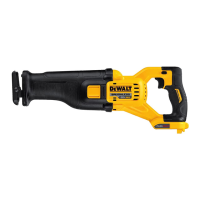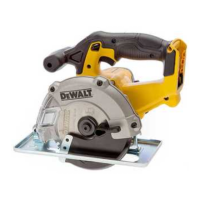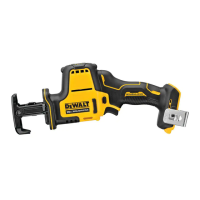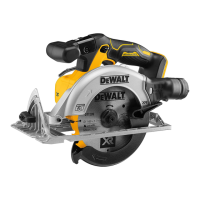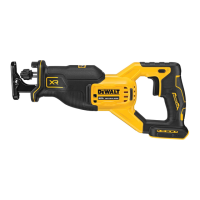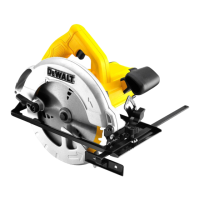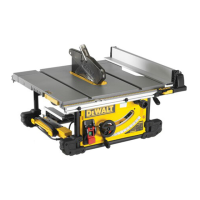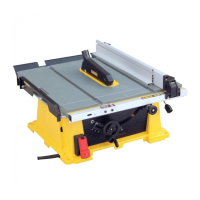11
ENGLISH
Proper hand position requires one hand on the main handle
8
,
or one hand on the main handle and one hand on the hand
grip
5
.
Cutting (Fig.D, F–H)
WARNING: Always use eye protection. All users and
bystanders must wear approved eyeprotection.
WARNING: Exercise extra caution when cutting towards
operator. Always hold saw firmly with both hands
whilecutting.
Before cutting any type of material, be sure it is firmly anchored
or clamped to prevent slipping. Place blade lightly against work
to be cut, switch on saw motor and allow it to obtain maximum
speed before applying pressure. Whenever possible, the saw
shoe must be held firmly against the material being cut. This
will prevent the saw from jumping or vibrating and minimise
blade breakage. Any cuts that put pressure on the blade such as
angle or scroll cuts increase potential for vibration, kickback, and
bladebreakage.
WARNING: Use extra caution when cutting overhead and
pay particular attention to overhead wires that may be
hidden from view. Anticipate the path of falling branches
and debris ahead oftime.
WARNING: Inspect work site for hidden gas pipes, water
pipes, or electrical wires before making blind or plunge
cuts. Failure to do so may result in explosion, property
damage, electric shock, and/or serious personalinjury.
Flush‑To Cutting (Fig.F)
The compact design of the saw motor housing and spindle
housing permits extremely close cutting to floors, corners and
other difficultareas.
Pocket/plunge Cutting – Wood Only (Fig.D, G)
The initial step in pocket cutting is to measure the surface area
to be cut and mark clearly with a pencil, chalk or scriber. Use
the appropriate blade for the application. The blade should
be longer than 90mm and should extend past the shoe and
the thickness of the workpiece during the cut. Insert blade in
bladeclamp.
Next, tip the saw backward until the back edge of the shoe
is resting on the work surface and the blade clears the work
surface (position 1, Fig.G). Now switch motor on, and allow
saw to come up to speed. Grip saw as shown in Figure D and
begin a slow, deliberate upward swing with the handle of the
saw, keeping the bottom of the shoe firmly in contact with
the workpiece (position 2, Fig.G). Blade will begin to feed into
material. Always be sure blade is completely through material
before continuing with pocketcut.
NOTE: In areas where blade visibility is limited, use the edge
of the saw shoe as a guide. Lines for any given cut should be
extended beyond edge of cut to bemade.
Metal Cutting (Fig.H)
Your saw has different metal cutting capacities depending upon
type of blade used and the metal to be cut. Use a finer blade for
ferrous metals and a coarse blade for non‑ferrous materials. In
thin gauge sheet metals it is best to clamp wood to both sides
of sheet. This will ensure a clean cut without excess vibration or
tearing of metal. Always remember not to force cutting blade as
this reduces blade life and causes costly bladebreakage.
NOTE: It is generally recommended that when cutting metals
you should spread a thin film of oil or other lubricant along
the line ahead of the saw cut for easier operation and longer
bladelife.
MAINTENANCE
Your power tool has been designed to operate over a long
period of time with a minimum of maintenance. Continuous
satisfactory operation depends upon proper tool care and
regularcleaning.
WARNING: To reduce the risk of serious personal
injury, turn tool off and disconnect battery pack
before making any adjustments or removing/
installing attachments or accessories. An accidental
start‑up can causeinjury.
The charger and battery pack are notserviceable.
C
Lubrication
Your power tool requires no additionallubrication.
D
Cleaning
WARNING: Blow dirt and dust out of the main housing
with dry air as often as dirt is seen collecting in and around
the air vents. Wear approved eye protection and approved
dust mask when performing thisprocedure.
WARNING: Never use solvents or other harsh chemicals
for cleaning the non‑metallic parts of the tool. These
chemicals may weaken the materials used in these parts.
Use a cloth dampened only with water and mild soap.
Never let any liquid get inside the tool; never immerse any
part of the tool into aliquid.
Optional Accessories
WARNING: Since accessories, other than those offered
by DeWALT, have not been tested with this product, use
of such accessories with this tool could be hazardous.
To reduce the risk of injury, only DeWALT recommended
accessories should be used with thisproduct.
Consult your dealer for further information on the
appropriateaccessories.
